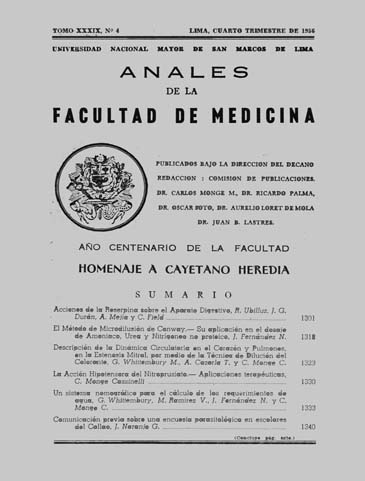Takayasu disease
DOI:
https://doi.org/10.15381/anales.v39i4.10760Abstract
Takayasu's disease or nonspecific arteritis young woman, was long regarded as a condition typical of the Asian race, a concept that has been distorted by Western publications increasingly frequent. From the clinical point of view is regarded as primarily neurological, cardiovascular and ocular manifestadones those discussed apropos of a personal case: ill 25-year-old with a history of probable tuberculous infection, who has six years a neurological condition characterized by headache paroxysmal, intermittent claudication and visual facio-brachial muscle; then a apoplectic stroke with coma for three days and right hemiparesis discreet; days after a new apoplectic stroke with coma vigil for two and half months, bilateral motor disorders, mixed aphasia a right hemiplegia persisted for seven months and then monopleiía with predominantly distal hypoesthesia brachial until today. The review found no pulse in both upper and left carotid members absent in higher blood pressure and hypertension in the lower extremities. The pathogenesis of vascular disease is briefly discussed, focusing mainly on the importance of aortic arch syndromes in cerebral circulation problems.Downloads
Published
1956-12-31
Issue
Section
Trabajos originales
License
Copyright (c) 1956 S. D. Roedenbeck, J. Bauer

This work is licensed under a Creative Commons Attribution-NonCommercial-ShareAlike 4.0 International License.
Those authors who have publications with this magazine accept the following terms:
- Authors will retain their copyrights and guarantee the journal the right of first publication of their work, which will be simultaneously subject to Creative Commons Attribution License that allows third parties to share the work as long as its author and its first publication this magazine are indicated.
- Authors may adopt other non-exclusive licensing agreements for the distribution of the version of the published work (eg, deposit it in an institutional electronic file or publish it in a monographic volume) provided that the initial publication in this magazine is indicated.
- Authors are allowed and recommended to disseminate their work over the Internet (eg: in institutional telematic archives or on their website) before and during the submission process, which It can produce interesting exchanges and increase quotes from the published work. (See El efecto del acceso abierto ).
How to Cite
1.
Roedenbeck SD, Bauer J. Takayasu disease. An Fac med [Internet]. 1956 Dec. 31 [cited 2024 Jul. 17];39(4):1407-16. Available from: https://revistasinvestigacion.unmsm.edu.pe/index.php/anales/article/view/10760















